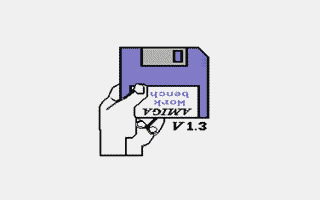

|
(click on picture) |
 |
| Boot screen the Amiga 500 |
| Introduced | January 1987 |
| Discontinued | ??? |
| Release Price | $595.95 |
| The
Amiga 500 was introduced in
January of 1987 along with the Amiga 2000. It was
designed to bring the powerful 32 bit 68000 processor;
the same processor used in the Macintosh, into the home
computer market previously dominated by the highly
successful C-64. The two computers were designed to replace the somewhat successful Amiga 1000 introduced in mid 1985. Commodore realized that to crack the highly competitive home market, it would need to lower the price of the A500 to be competitive, the original A1000 sold for a list price of $1295 when it was introduced. Commodore introduced the A500 at a list price of $595.95. In order to get down to this the A500 when through some major design changes. The most obvious change was to the computers appearance. The first to go was the detachable keyboard and IBM style CPU box to sit the monitor on. The A500 was made to look more like the C128 with the keyboard placed in a plastic housing and placed on top of the motherboard all in one unit. To further cut costs, new custom chips and gate arrays were designed to take over functions previously performed by off the shelf chips. For example, the Agnus chip was redesigned to become the Fat Agnus chip and incorporated all the surrounding support circuitry of the chip. More powerful chips mean less complex, easier to build motherboards. Another major change was to put the 'Kickstart' into ROM. The Kickstart is the Amiga's operating system which had previously been disk based for the A1000, and had to be loaded into a specially protected 256k part of RAM called WCS (Writeable Control Store). This was a welcome improvement because the floppy load was time consuming. The A500 also came with 512k of user RAM easily expandable to 1 MB with the insertion of a memory cartridge that plugged into a compartment on the underside of the unit. It could also be expanded to maximum of 9 MB through the expansion port on the left side of the unit. There are two game controller ports located on the back of the computer. The computer's great graphics capability requires an RGB monitor, in fact there is no hookup for a television or composite color monitor, although it does have a mono output for a hi-res monochrome monitor to do word processing applications. It uses standard RS232 and Centronics parallel printer interfacing and has a built in 3.5 inch - 880k floppy drive on the right side. |
| System Architecture | Ports | Data Storage | ||||||||||||||||||||||||||||||||||||||||||||||||||||||||||||||||||
|
|
|
||||||||||||||||||||||||||||||||||||||||||||||||||||||||||||||||||
| Memory | Video and Graphics | |||||||||||||||||||||||||||||||||||||||||||||||||||||||||||||||||||
|
|
|||||||||||||||||||||||||||||||||||||||||||||||||||||||||||||||||||
| Physical Specs. | Software | Power | ||||||||||||||||||||||||||||||||||||||||||||||||||||||||||||||||||
|
|
|
||||||||||||||||||||||||||||||||||||||||||||||||||||||||||||||||||
| Sound | Keyboard Specs. | |||||||||||||||||||||||||||||||||||||||||||||||||||||||||||||||||||
|
|
|||||||||||||||||||||||||||||||||||||||||||||||||||||||||||||||||||
System Architecture |
Memory |
|||
| Microprocessor | 68000 | Standard on system board | 1 MB | |
| Clock speed | 7.14 MHz | Maximum on system board | 1 MB | |
| Bus type | CBM proprietary | Maximum total memory | 9 MB sidecar | |
| Data bus width | 16-bit | Memory speed and type | 120ns dynamic ram | |
| Address bus width | 24-bit | System board memory socket type | ??? | |
| Interrupt levels | N/A | Number of memory module sockets | ??? | |
| DMA channels | N/A | Memory used on system board | ??? | |
Standard Features |
Disk Storage |
|||
| ROM size | 256k | Internal disk and tape drive bays | 1 - 3.5 inch | |
| Optional math coprocessor | 68881 | Standard floppy drives | 1 - 3.5 inch 880k | |
| Parallel port type | yes | Optional floppy drives: | external | |
| RS232C serial ports | yes | * 5 1/4 inch 360k | optional | |
| Mouse ports | yes - joystick | * 5 1/4 inch 1.2MB | optional | |
| UART chip used | N/A | * 3 1/2 inch 880k | 1 standard | |
| Maximum speed | N/A | * 3 1/2 inch 1.44MB | No | |
| CMOS real time clock | yes | * 3 1/2 inch 2.88MB | No | |
| CMOS RAM | yes | Hard disk controller included | No | |
Video & Graphics |
Sound |
|||
| Graphics Processor | Fat Agnus, Denise, Paula | Sound Interface device | ||
| Screen size - Col x Rows | 80 x 25 | Sound generation | ||
| Resolution - Colors/High | 4 - 640 x 200 pixels | ADSR capable | ??? | |
| Resolution - Colors/Low | 256 - 320 x 200 pixels | |||
| Max colors | 4096 | Programming language | ||
| Sprites or Missiles | ??? | Built in language | Amiga Basic / CLI | |
| Built in M L monitor | no | |||
Expansion Slots |
Keyboard Specs. |
|||
| Total adapter slots | 1 | Number of keys | 95 | |
| Number of 8/16/32 bit slots | 0/0/1 | Upper/lower case | yes/yes | |
| Keyboard cable length | N/A | |||
Physical Specs. |
Environmental Specs. |
|||
| * Height | inches | Operating voltage @ 60 Hz | 117 VAC | |
| * Width | inches | Maximum power supplied | ||
| * Depth | inches | Power supply output - volts | N/A | |
| * Weight | pounds | Power supply output - amps | N/A |